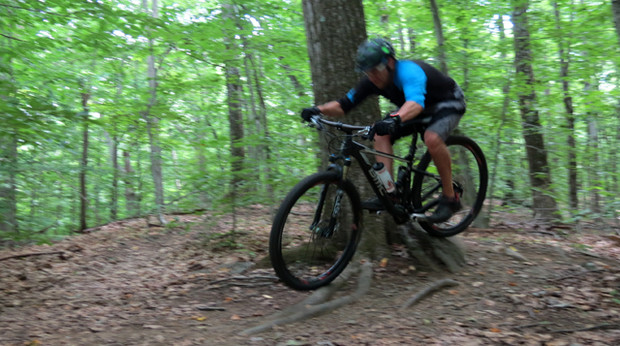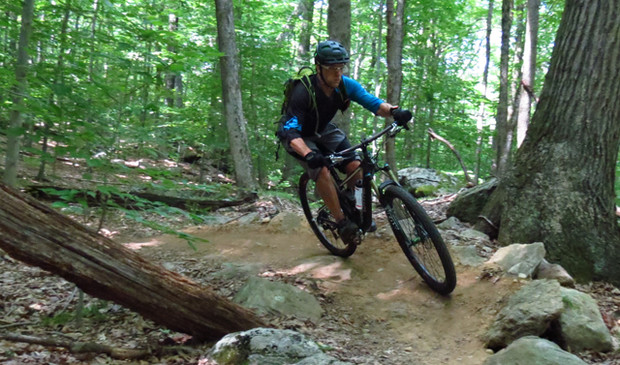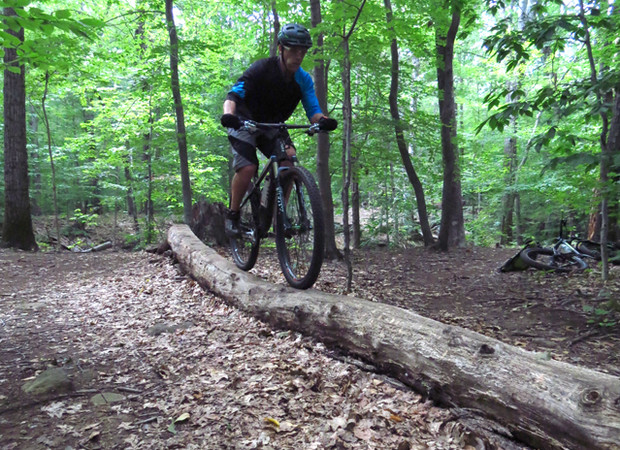 Keep up with THAT, Joneses. GW Photo
Keep up with THAT, Joneses. GW Photo
Trail is a funny category. The bikes have 120-140mm travel and are designed to be proficient on most rides—smooth or burly—with the implied promise of being able to handle some terrain moderately out of their comfort zone.
RELATED: Initial Ride Report - BMC Trailfox 02
The trap most people fall into (myself and other reviewers included) when evaluating a trail bike’s ‘versatility’ is pushing it to see how much rough abuse it can handle and still remain poised. Then, when we inevitably find its inflection point, we whine about the fork not being stiff enough or the bike’s too-steep geometry. “If only it had X, Y or Z then it could handle blah blah…” So a trail bike’s metric then becomes how far into a 150/160mm-travel zone it can go.
The Setup
 Gotta admit, this indicator takes the suck out of sag. GW Photo
Gotta admit, this indicator takes the suck out of sag. GW Photo
I started off down the same rabbit-hole with the 130mm Speedfox. I set the sag (the bike has an ingenious sag indicator, btw) in the plush zone, converted the tires to tubeless to run softer pressure, ran the fork soft to go through more if its travel etc. I then took it out on some rocky east coast trails and was unhappy. Very unhappy.
 At first, this was kind of the upper limit. Dave Peters photo
At first, this was kind of the upper limit. Dave Peters photo
I just couldn’t understand what this bike was about. It was zippy, but wanted no part of anything slightly more than ‘trail’ technical. And not only that, its narrow cassette and double chainring were always getting in the way of the short, but radical, ups and downs of the east coast.
 But I don't want to launch off of a root. Dave Peters photo
But I don't want to launch off of a root. Dave Peters photo
Bikes from sophisticated companies, especially Swiss R&D design and engineering psychos like BMC, don’t usually fail. I was annoyed, but knew there was something I just wasn’t putting my finger on that would explain this initial lack-luster feel. I'd ridden their APS suspension in the past, so I know it can work. APS uses a floating four-bar-like system which leverages chain tension to help mitigate compression forces. Pedaling increases tension on the chain and, thus, you feel very in control of the SpeedFox's suspension while pedaling (DW-link bikes have a similar characteristic).
Then, a week or so ago, I was watching the Tour de France and my wife said “hey, a BMC team, is that the same company as that bike in the garage?” Why yes… yes it is. Then it dawned on me. BMC is a race company; the DNA of their bikes is high-RPM speed, built for the likes of Cadel Evans, Fabian Cancellara and Julien Absalon. They are created to pass other riders. The ‘versatility’ of this trail bike may not be how well it takes on the burly end of the mountain bike spectrum, but a fast marathon/endurance race capability.
The Sweetspot
 Stewart45 endurance XC. The SF02 was home at last. GTLuke photo
Stewart45 endurance XC. The SF02 was home at last. GTLuke photo
Eager to test this theory, and not wanting to mess around, I entered the Stewart45, a 45-mile endurance race held at one of the faster, more buff areas here in the northeast (Dear BMC; yes, I raced your review bike, sorry). I set the sag and fork firm, 10-15%, I pumped up the tires and raised the saddle to roadie height, maximizing pedaling efficiency (it still has a dropper for downs). And off I went.
Great race, lots of fun. Unfortunately it was 95 freaking degrees and 100% (or whatever maximum is) humidity. But the bike was loving it. Though a tad heavier than some of the 20/21lb pure XC rigs on the course, the SF made up for it with superior capability. As noted in the last review, it climbs great. In fact, the suspension rewards charging right at big rock wall climbs and baby-head gardens.
 The capable 130mm fox float CTD shock and APS suspension system. GW photo
The capable 130mm fox float CTD shock and APS suspension system. GW photo
Where XC bikes had to be more careful, I could go right at the rough stuff. Of course the SF has 29er rollover, though all bikes there had that. Rock features other bikes had to roll down, I could boost off of and land flat (Dear BMC: yes, I hucked your bike to flat, sorry). And with a dropper and pretty decent tires, I gained time on descents.
 The Continental X-king rear and Mountain King front tires. GW Photo
The Continental X-king rear and Mountain King front tires. GW Photo
BMC's closely-packed 11-36 cassette choice finally became clear. When spinning at a continuous 90-110 rpm, you shift to maintain cadence—not in response to terrain. FYI, BMC is switching to an 11-40 cassette for 2016, so problem solved regardless.
 For long rides, the double ring makes sense, and I always appreciate a chainguide. GW photo
For long rides, the double ring makes sense, and I always appreciate a chainguide. GW photo
If your legs feel good, you’re in the big, 38t chainring, if you’re deep in the hurt box, the small 24t. I even raised my saddle a centimeter higher than I thought I should on some good advice from a bike fitter at the race, for a racier XC position.
The Speedfox Win
 Pedal it, and then pedal it some more. Dave Peters photo
Pedal it, and then pedal it some more. Dave Peters photo
So there it is. Fast is how you win on this trail bike. Just keep the power down and the SpeedFox is happy on group and Saturday rides. Set your tires and suspension firm, 20% sag for trail, and spin it to win it because the bike rewards aggressive high-cadence riding.
You can’t twiddle around and wait for suspension and inertia to badonka-donk your way though things. Wait for your buddies at a trail junction, because you’re going to arrive first. If they don’t like it, find faster friends.
 It's actually good at skinnies too, which is nice. Dave Peters photo
It's actually good at skinnies too, which is nice. Dave Peters photo
And race this bike XC (the good news: XC courses are being set more aggressively now, which plays to this bike’s strength). If you got crazy about racing, you could drop some weight with lighter parts once the originals wear out in a couple years. And it has short chain-stays and is capable of having some fun.
 Chillin' waiting for friends to catch up. Dave Peters photo
Chillin' waiting for friends to catch up. Dave Peters photo
Pros: Fast, rewards hard efforts, solid brakes, very good rear suspension design, category leading dropper post, good cockpit, sharp looks (Bond villain sharp), and good tires. Once you get comfortable on it, it's fine on technical trails.
Cons: not a park bike and, if you’re a bigger guy, over 185 or so, you’ll probably notice the flex on the 32mm stanchion fork – the 32mm float CTD fork is just not a great fork. BMC has switched to a 34mm stanchion fork for 2016 (Hurray, problem solved). Not sure size recommendations were right, I had to put a longer stem on my medium. If you think you're a large, buy a large, despite their medium recommendations. And WHY is the front rotor 6-bolt and the rear centerlock – makes no sense.
Buy it if: You’re a flow-y trail rider that likes to enter XC or endurance races. Or just feels the glory of fast cadence, high RPM efforts. And if you’re 5.10” or 5.11”, test ride carefully because that’s right where the cusp of medium and large is. If you end up a medium, you’ll probably have to go with a longer stem.



evan.lloyd9
August 5th, 2015
After that review i’m sure they’ll be cool with you hucking anything of theirs to flat. Sounds like my kind of bike!